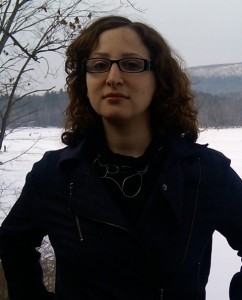
Rebecca Uchill
Caring for contemporary artworks usually requires a team effort.
I’ve been fortunate at the Indianapolis Museum of Art to work with colleagues who take their role in caring for artworks very seriously. For instance, I worked with former Associate Curator of Contemporary Art, Rebecca Uchill, who arrived in 2005 and left Indy in 2008. Soon after her arrival, she began putting together exhibitions that among other things challenged the existing procedures of the museum and in a variety of ways pushed us to more clearly define our roles. In 2008 Uchill left Indianapolis to pursue a PhD at the MIT department of History, Theory, and Criticism of Art and Architecture. While I appreciated the exhibitions she brought to the IMA, one the most important projects she spearheaded is the creating of the Variable Art Team (VAT), an interdisciplinary team focused on the preservation of artworks that possess a changing observable state. Such artworks can involve variable presentation formats, time-based fluctuations or other types of variables, for example:
- Installation or site-sensitive artwork with artists’ instructions for implementation;
- Electronic or media-based art with updating platforms and devices;
- Conceptual art, ephemeral art, or art made with unsustainable materials.
Since Uchill’s departure, the VAT, currently led by Associate Curator of Contemporary Art, Sarah Urist Green and myself, has grown in scope and continues to be a museum-wide collaborative and interdisciplinary effort.
Richard McCoy: Will you go back to 2006 and talk about what you had in mind when you started the Variable Art Team (VAT)?
Rebecca Uchill: I had been speaking with my friend Cara Starke, Assistant Curator of Media Art at the Museum of Modern Art (MoMA), about their similar inter-departmental group, and I was also interested in the work of Jon Ippolito in naming and thinking freshly about Variable Media. My original, very simple intention was to make clear and evident that everyone had a role not only in the process of putting an artwork on exhibition and that these roles also contributed to an artwork’s preservation in different ways. As you know, sometimes documents related to the production of artworks weren’t archived because they seemed incidental at the time, but they would later emerge as essential–or at least desirable–records. For example, an artist’s napkin sketch drawn in the exhibition design offices might later become an important art historical document, as well as a partial roadmap to future re-creation of the work.
RM: I think finding, storing, and then retrieving all of the necessary documents around contemporary projects is among the biggest challenges facing institutions these days. One thing I remember from those early meetings is that we didn’t want to make any new institutional policies, and we didn’t want to try and force people to attend the team meetings. Raising awareness of what each person’s role in the exhibition and preservation of an artwork is complicated enough. I also remember spending a lot of time working with the VAT to make the “Variable Artwork Production and Archiving Flowchart.” While that isn’t always how artworks are produced at the IMA, it provides a good framework for how they could be commissioned.
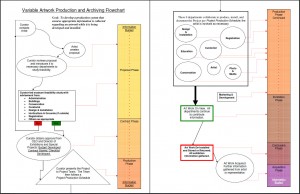
Variable Artwork Production and Archiving Flowchart Rev. 1.1 (2008)
RU: The flowchart definitely forced a conversation about what people were actually doing, and demonstrated that almost everyone has a role. It made it possible to have a more nuanced conversation about what interactions or transactions were happening at each stage of a process.
From your perspective as a conservator, it seems what’s interesting (with the flowchart) is to figure out the legacy of the documentary traces of an artwork’s production. But what I find additionally interesting, as an art historian, is to see the distributed agency in the production of an artwork made manifest through that kind of chart. One often conceives of an artwork as being the product of a particular artistic position, but frequently it’s not that way entirely. There are other attributes–as with any other creative or productive act–that influence the outcome. Thinking about those influences that result from institutional contexts of production and display is now an academic focus for me.
This summer, for example, I am going to work in residence at the Canadian Centre for Architecture (CCA), where I will conduct research on the ways that certain 20th- and 21st-century museum architectures have affected contemporary art or reflected its changing approaches, especially towards the performative and dialogical.
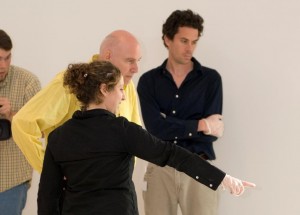
Rebecca Uchill, Adrian Schiess, and Richard McCoy installing Schiess' 2007 IMA exhibition.
RM: Today, I can say that IMA conservation, curatorial, registration, and other departments work together well and understand their integrated roles. And just recently two museum educators began coming to the VAT meetings. We are hoping that education is going to be a big part of the VAT in the future. Sarah and I have been planning a number of conservation-related projects that have all come out of our VAT meetings, and they all seem to revolve around the way we educate visitors at the museum. We want to make more public our work and push some of our thinking out into the galleries through didactics and a video.
RU: I think that’s much more interesting than many other kinds of “behind the scenes” exhibition documentaries that are out there. The idea of how the installation of an artwork affects what you see is elucidating and fundamentally relevant to the mission of the museum. I’d like to see more of this.
RM: Yeah, me too. We’re also thinking about how docents and security guards affect the experience of seeing a work in the gallery. In particular, we’ve been thinking about the installations Untitled by Fred Sandback and Acton by James Turrell.
RU: That’s really great. This kind of inquiry is exactly what I think we need to be more aware of in the academy. Just as one example: the concept of relational aesthetics is so theoretically predicated on how people interact with and around art projects, and yet there’s so little attention paid to how people actually interact with art outside of theory or after the opening reception, once it’s placed on long-term display.
Instead, it seems like people tend to think in the abstract about projects like Rirkrit Tiravanija’s Pad Thai, which involves serving food to audience participants, as a site for democratic interaction. When Claire Bishop reconsidered the “intrinsic” democracy of Bourriaud’s Relational Aesthetics in her 2004 article in October, she pointed to a review by Jerry Saltz that demonstrated how the project had been a meeting-site for art-world networking, for a delimited sphere of participants. But when I saw the re-creation of Tiravanija’s Untitled (Free) project in 2007 at David Zwirner gallery, I just felt hungry!
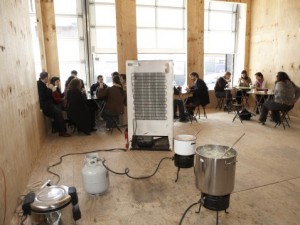
2007 Recreation of Rirkrit Tiravanija’s "Untitled (Free)" at David Zwirner Gallery
I hate to admit it, because I made that trip to New York primarily to see the piece. But after a long day of gallery-hopping, my experience was really more about feeling starving than feeling social. Most of the participants there that day were sort of restless and waiting for the rice to finish being cooked. I’m not sure what I was expecting.
On this note, I’ve been thinking about methodologies for better thinking and writing about interactive or audience-participatory work. I noticed your discussion here with Glen Wharton, who we were in communication with when we began the VAT project. You cite the INCAA document that suggests modes for communicating with artists, and Glenn talks more explicitly about borrowing from anthropological methods for interviewing artists. I’ve been thinking about anthropology too, as a disciplinary consideration.
I’m curious about how to best report on audience experiences, including my own, when the art itself is inherently experiential. How does one write criticism that does justice to the immersive, subjective nature of it, without it becoming simply autobiographical reportage? One person I just became aware of recently who is doing really interesting work with ethnography in the museum is Albena Yavena. She applies actor network theory from science studies to objects as agents at work in design and in the museum. Her article about the installation of Muckenbus by Carsten Höller/Rosemarie Trockel examines the roles of the curator, museum technicians, and others in the corporeal realization of that piece–and also shows how the art object itself provoked social relations and linkages between the interior and exterior of the museum space. The article is titled, “When a bus met a museum,” and you can find it in the November 2003 issue of Museum and Society–I highly recommend it.
RM: You know sometimes, when I’m working on a project it’s hard to recognize all the important questions. I’m usually so busy just trying to make the project happen – and, not to be a downer – but I also think a lot about how patrons might negatively interact with an artwork and what we can do to protect it while it’s on view.
I think one of my primary roles in the display of contemporary art is to understand and legitimize the risk we take when we display it. When we agreed to take a paycheck for working at a museum, we agreed to put artwork on display; from an idealistic (art conservation) perspective, in this way we’re already operating from a position of loss. Of course, there are ways to minimize risks, but in complex installations, sometimes you don’t even know all the risks. You can’t predict all of the things that patrons are going to do.
Also, it’s awfully hard to understand all of the different kinds of materials artists use and how they will degrade over time (or even what ones should be degrading, or eaten in the case of Pad Thai). This is why the VAT is so vital, because we can discuss projects and then make decisions together, and then no one person is out on an island when a decision is made.
RU: This whole process of consultation and negotiation–the flowchart, so to speak–is about who gets a voice. Fire code, for example, can change an installation art work. Your voice and my voice very often changed the display of works at the IMA, allowing a piece of minimalist sculpture to be displayed with or without a stanchion, for example.
In your interview with Jorge Oteros-Pailos, who taught a class here at MIT last year, I was interested in his notion that conservators aspire to be invisible. He later discusses conservators’ projects that are being made visible or otherwise integral by artists. I think what we tried to do at the IMA was to make conservation work un-invisible, and integrated in the production of art, and not in a post-facto manner. We would have meetings with artists from the earliest stages of their proposals that didn’t just address how to produce and display the works during the run of the exhibition, but anticipated how something should be kept, if at all.
Sometimes we acquired the work, and sometimes not. But the artists’ interviews were very important documents. At least two institutions requested our interviews, installation diagrams, and other materials for files associating with works in their own collections.
RM: What else are you working on at MIT?
RU: Well, outside of the classroom, I’m organizing the List Center’s 2010 Wasserman Forum, with the title “‘Parody, Politics and Performativity.” The event will take place on March 13 at 3pm at MIT, and is free and open to the public. When I proposed doing a performance-based theme, MoMA had recently announced the expansion of their Media Art Department to include performance, and it seemed like an interesting time to consider performance in the institution. The forum is now taking shape under the guidance of our moderator, Jens Hoffmann, and will feature artists like Tania Bruguera and Tino Sehgal. I’m very excited about the program. The calendar on the List Center website will soon be updated with information about the Forum, so check back there for more details.
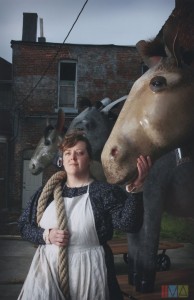
Allison Smith with "The Donkey, The Jackass, and The Mule," 2008. Photograph by Michelle Pemberton.
I also recently wrote about the project with Allison Smith that we worked on together at the IMA for On Procession, called The Donkey, The Jackass, and the Mule.
As you remember, the discussions about conservation of Allison’s work were pretty complicated, given that it had been produced as a performance piece but would live in the museum as an installation. I was interested in re-thinking this project. Allison is very interested in re-enactments and living history practices. I wanted to compare the interpretive act of history that happens thematically in her work with the interpretive act that is required when collecting, preserving, and displaying her art. With variable art, like Allison’s, so much of the ongoing display of the work is based on the institutional interpretation of the piece: how it will be installed, contextualized, and possibly used, if it will ever be activated again.
In another project by Allison, she learned how to make Ruskin Lace. John Ruskin was a big advocate of putting meaningful handiwork into the hands of the people, so that they would not suffer from the moral impoverishment casued by the industrial revolution. I once heard Allison speculate that this particular lace-work tradition continues to exist because of 20th-century practitioners who insisted that a special linen not be discontinued. From Ruskin to the lace-tradition preservationists, there is a strange kind of moral certitude and material finality that lingers in the background. Not to say that’s what you do, but there is a parallel in the sort of suspension of time that happens when you freeze a tradition or declare an artwork to be its own final version, so that it will no longer be subject to change. That’s been the mandate of conservation, traditionally. But if you think about Ruskin and the lace, or the question of preserving performance props so that they cannot be re-used, it seems to me that there’s an important question – is it always the ethical thing to save something?
RM: Traditionally, art conservators focus their efforts on saving artworks from harm (light, poor climate, etc). Or they are charged with restoring artworks to some kind of authentic state of representation. Having an artwork that has a performative aspect isn’t something that we’re really accustomed to dealing with. It requires a new kind of thinking–and, really, it’s at this point when the words conservation, preservation, and restoration all become inaccurate in some way.
Works like Allison Smith’s really challenge me to understand not only what my role is alongside the artwork, but also to understand what the artwork is and can be. But no matter what kind of project an art conservator is working on, I think the first step is to understand what it is and from where it came. This goes for everything from archeological finds to artworks being made today. Only then then can we deal with how to display it.
Also, and I may not be a “real conservator” to say this, but I’m really okay with some artworks going away forever, and also okay with some artworks evolving and changing inside the institution. I think this is just being honest and understanding that not everything is here forever.
I think this is such a great question to end on, and I want to leave it open for others to consider.



